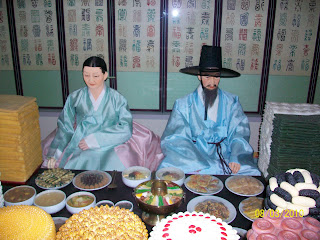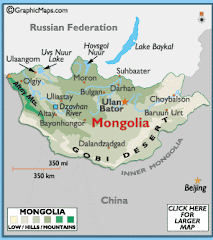Our temporary visas to Mongolia ran out March 3. We arranged to have the University where we teach English be our sponsor and get new visas through them, but had to go to Korea to get this done. We thought it would only take a few days, but it has taken two weeks. We are going back to Mongolia tomorrow. We have enjoyed learning about Seoul, Korea. It is a vary modern city and we have enjoyed being in a more modern place for a while too. There are many things that are very different to us here. One of the first things we noticed was the food. Many of the restaurants have tanks like this one out in front where you can choose your dinner:
 It has been wonderful to be near a temple and go there again. We stayed in the temple housing and were able to attend the temple almost every day we were here.
It has been wonderful to be near a temple and go there again. We stayed in the temple housing and were able to attend the temple almost every day we were here. There are street venders like these all over. They make a very good tempura with shrimp or vegetables. Some of the other dishes were kind of suspicious looking.
There are street venders like these all over. They make a very good tempura with shrimp or vegetables. Some of the other dishes were kind of suspicious looking. Seoul has about 20 million people in the metropolitan area. It is prosperous and very modern. They still have many of their old palaces like the one in this picture. They are very interesting to see. It can be quite cold here, but they had a system of building fires under the homes and heating the floors.
Seoul has about 20 million people in the metropolitan area. It is prosperous and very modern. They still have many of their old palaces like the one in this picture. They are very interesting to see. It can be quite cold here, but they had a system of building fires under the homes and heating the floors.. One of our first visits was to the Mongolian National museum where we learned a lot about Mongolian history. Here is one of their ancient warriors.
One of our first visits was to the Mongolian National museum where we learned a lot about Mongolian history. Here is one of their ancient warriors.
 One of our first visits was to the Mongolian National museum where we learned a lot about Mongolian history. Here is one of their ancient warriors.
One of our first visits was to the Mongolian National museum where we learned a lot about Mongolian history. Here is one of their ancient warriors.  Skyline of the city behind the view of the Han River. During the Korean war there was only one bridge over this river. Now there are about 18.
Skyline of the city behind the view of the Han River. During the Korean war there was only one bridge over this river. Now there are about 18. This was a "women's rights" demonstration we ran into on International Women's Day. The dancing was interesting.
This was a "women's rights" demonstration we ran into on International Women's Day. The dancing was interesting.
 One day we went to a restaurant run by a former Budhist Monk. Because they had to hide out in the forests during the Confuscionist time period, they learned to eat what they could find there. Some looked like it was covered with moss. My favorite dish was the “porridge of the season.” We also had watery plain kimchi (a spicy cabbage soup), a vegetable pancake, seven wild vegetables each with its own seasonings, kimchi, seasoned fresh lettuce, cooked roots of balloon flowers and fern bracken, fried kelp, steamed beancurd with burdock, mushroom, carrots, small potatoes glazed with soy sauce and millet syrup (these were good), seasoned wild mountain roots, special chopsuey made with vegetables andmushrooms, three kinds of fritters of fried seasonal vegetable, seasonal Buddhist monk’s favorite vegetables, three kinds of pan fried seasonal vegetable pancakes, rice with beans, millet, etc., soybean stew with mushrooms, radish, red peppers, beancurd, etc.
One day we went to a restaurant run by a former Budhist Monk. Because they had to hide out in the forests during the Confuscionist time period, they learned to eat what they could find there. Some looked like it was covered with moss. My favorite dish was the “porridge of the season.” We also had watery plain kimchi (a spicy cabbage soup), a vegetable pancake, seven wild vegetables each with its own seasonings, kimchi, seasoned fresh lettuce, cooked roots of balloon flowers and fern bracken, fried kelp, steamed beancurd with burdock, mushroom, carrots, small potatoes glazed with soy sauce and millet syrup (these were good), seasoned wild mountain roots, special chopsuey made with vegetables andmushrooms, three kinds of fritters of fried seasonal vegetable, seasonal Buddhist monk’s favorite vegetables, three kinds of pan fried seasonal vegetable pancakes, rice with beans, millet, etc., soybean stew with mushrooms, radish, red peppers, beancurd, etc. About this time I began to think we should take advantage of the familiar chains (like MacDonald's, Burger King, Pizza Hut) that we don't have in Mongolia!

.jpg)
 Here we are at Gyeongbokgung Palace. We arrived in time to see the "changing of the guards." (above)
Here we are at Gyeongbokgung Palace. We arrived in time to see the "changing of the guards." (above)We learned in the palace that few people lived to age 60, so for those that did their children held a special party and gave them gifts, etc. The picture below shows a 60-year-old couple being honored. I guess we missed out on that custom...
One day we woke up to about 5 inches of snow--quite rare in Seoul. The bushes and trees around the temple looked very pretty.
 Namendaemun Market is a place with blocks and blocks of shops of all kinds of fabrics, buttons, sewing notions, and things made of fabrics. We didn't begin to see it all, but did enjoy the tie section. There must have been ties in the millions. This picture just shows the corner of one shop and there were many, many more shops.
Namendaemun Market is a place with blocks and blocks of shops of all kinds of fabrics, buttons, sewing notions, and things made of fabrics. We didn't begin to see it all, but did enjoy the tie section. There must have been ties in the millions. This picture just shows the corner of one shop and there were many, many more shops.  This is a rice field that we saw when we took a trip to a city (Suwon) near Seoul. It was fun to see another part of Korea. Below shows a river where there were many people on the shore and also on small "house boats" fishing.
This is a rice field that we saw when we took a trip to a city (Suwon) near Seoul. It was fun to see another part of Korea. Below shows a river where there were many people on the shore and also on small "house boats" fishing. 
In Sewon we went to a "Folk Village." There we saw living quarters and exhibitions of things from Korea in past times.
These dancers were very interesting. Some of them had "ribbons" attached to their hats that they could swing around by moving their heads to give a beautiful effect to their dancing.
 The tight rope walker would stop in between his different feats and tell jokes--too bad we could not understand Korean!
The tight rope walker would stop in between his different feats and tell jokes--too bad we could not understand Korean! This was the reenactment of a traditional Korean wedding. Typically the bride and groom were very young--sometimes as young as 10 years old. And they often had never seen each other before.
This was the reenactment of a traditional Korean wedding. Typically the bride and groom were very young--sometimes as young as 10 years old. And they often had never seen each other before.Below you can see the groom on the horse and the bride in the carriage that was carried by four servants in a procession after the ceremony.
 The detail on the roofs in the Budhist temples is very detailed. These are guardians of the gate to the Budhist temple. I have seen them also in a Budhist temple in Mongolia.
The detail on the roofs in the Budhist temples is very detailed. These are guardians of the gate to the Budhist temple. I have seen them also in a Budhist temple in Mongolia. One of the most touching things we visited was the Korean War Memorial. Out in front is a scupture of "Two Brothers." This represents families that had members fighting on both sides of the war. There is a great desire in South Korea to be reunited with North Korea and have one free land. Right now I don't think the dictator of North Korea is about to let that happen.
One of the most touching things we visited was the Korean War Memorial. Out in front is a scupture of "Two Brothers." This represents families that had members fighting on both sides of the war. There is a great desire in South Korea to be reunited with North Korea and have one free land. Right now I don't think the dictator of North Korea is about to let that happen. We learned that Korea has been attacked over 960 times in its 5000 year history. The Korean War was a particularly hard war because families were divided and on both sides. North Korea attacked with many Russian tanks and other military equipment while South Korea had none. If the US and other countries had not come to their aid, there was no way they would have survived. They are very appreciative of this help even today.
We learned that Korea has been attacked over 960 times in its 5000 year history. The Korean War was a particularly hard war because families were divided and on both sides. North Korea attacked with many Russian tanks and other military equipment while South Korea had none. If the US and other countries had not come to their aid, there was no way they would have survived. They are very appreciative of this help even today. Here you can see the Korean flag flying by the Seoul temple.
Here you can see the Korean flag flying by the Seoul temple. We are thankful for the friendliness and helpfulness of the Korean people. Everywhere we went they wanted to help us. But we are ready to go back to Mongolia and get back to work!












No comments:
Post a Comment